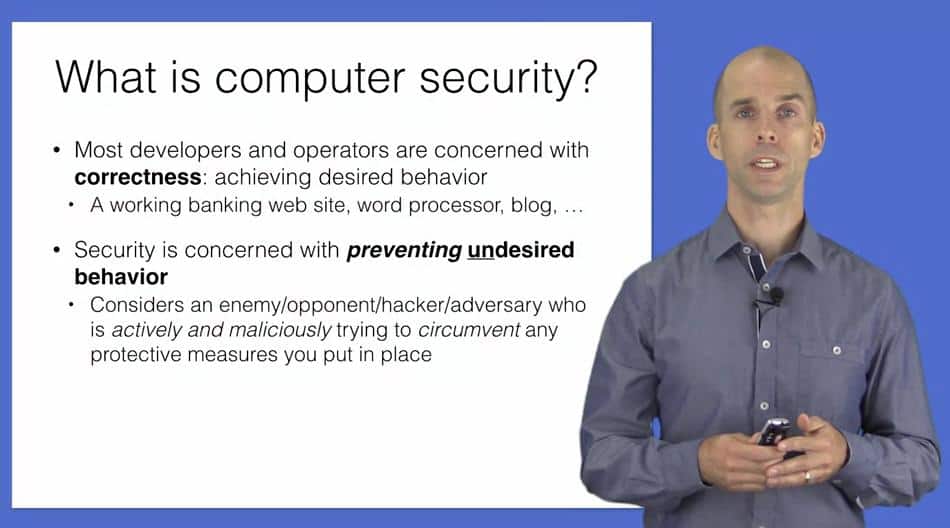In-Depth Review: Software Security from the University of Maryland
Detailed review by Class Central user Henrik Warne on this stack smashing, buffer overflow exploiting cybersecurity course.
This is a post by Class Central user Henrik Warne, originally posted on his blog and republished with his permission here on Class Central. Henrik is a software developer in Stockholm, Sweden. He has been programming professionally for more than 20 years, and still loves to code!
Took the course? Write your own review here. Read all reviews.
I just finished taking the course Software Security from the University of Maryland via Coursera. It was a relatively easy course (at least if you know the programming language “C”) that gave an overview of the following areas: buffer overflows and other memory attacks; web security (including SQL injection, CSRF, and XSS); secure design; static analysis; symbolic execution; fuzzing; and penetration testing. The instructor, professor Michael Hicks, was one of the more pedagogical lecturers I have listened to, and the whole course was quite enjoyable.
The instructor, professor Michael Hicks, was one of the more pedagogical lecturers I have listened to, and the whole course was quite enjoyable.
MEMORY-BASED ATTACKS
The first part of the course deals with buffer overflows and related memory exploits, as well as various defenses. For this part, it really helps if you know C, since all the examples are in C. Professor Hicks does a really good job of explaining how buffer overflows work, including how the memory is laid out, the difference between the stack and the heap, and so on. I was familiar with buffer overflows, but format string attacks were new to me.
In week two, various schemes to protect against memory-based attacks are explained. This includes:
- stack canaries (magic numbers in certain positions on the stack to help detect overwritten memory);
- data execution protection (only code in certain regions of memory is actually executable);
- address space layout randomization (to make it harder for an attacker to know where to jump to); and
- control flow integrity (to make sure a jump to an instruction comes from where you expect it to come).
Almost all of these techniques were new to me, and it was quite fascinating to learn about this continuing arms race of attacks and countermeasures.
WEB SECURITY
The third week of the course is about security on the web, and this felt like the most relevant part for me. SQL injection attacks are explained first, then some countermeasures: for example, the use of prepared statements. Next is a section on the risks of using hidden fields and cookies. Finally, professor Hicks explains session hijacking, cross-site request forgery (CSRF), and cross-site scripting (XSS). As with the section on memory attacks, professor Hicks does an excellent job of explaining all these attacks — his approach is very pedagogical, with many helpful diagrams and animations.
DESIGN PRINCIPLES
Week four starts with threat modeling. For example, an adversary can be able to access the system via the internet, or can snoop on the traffic, or can be co-located (as malware reading key strokes, for example). Next, some design principles are presented: favor simplicity, trust with reluctance, defend in depth, and monitor and trace. There is a risk of getting too abstract when describing design principles, but I think professor Hicks did a good job by giving examples of what they mean in practice. I also really liked the case study at the end, which is about design decisions taken when developing the Very Secure FTP Daemon.
STATIC ANALYSIS & SYMBOLIC EXECUTION
I was familiar with static analysis, but symbolic execution was new to me. Both are ways to analyze programs without running them. In the context of this course, these things are taught to avoid security vulnerabilities, but of course the techniques are equally applicable simply as ways to find bugs (whether security vulnerabilities or not).
Different concepts such as flow-, context- and path-sensitivity are explained in the section about static analysis. Symbolic execution attempts to find all possible inputs that can cause various parts of a program to be executed, and then tries to see if any of those values could cause an error. Some programs (like a parser) are easier to analyze in this way than others (for example, long-running programs with lots of external interactions), but what can be achieved with this technique is quite impressive. A number of symbolic execution tools, like KLEE (used in project #3), are mentioned.
FUZZING & PENETRATION TESTING
Finally, penetration testing and fuzz testing are explained. I have been impressed with fuzzing ever since I used it when I developed embedded VoIP (voice over IP) systems. We used a homemade fuzzer to test our implementation of the H.323 protocol. The protocol was binary encoded, and we simply sent random bytes to it, which caused in to crash in several different ways. Even though we had tested the implementation before, we did not come up with all the weird cases that the random input data produced.
Even though I was familiar with both topics, it was nevertheless interesting to hear about the different tools that are available today.
QUIZZES
There are six quizzes, one per week, with about 15 multiple choice questions in each (some with several correct answers). The questions test your understanding of the material from the video lectures. Some questions were quite easy, and some, especially where there were code snippets to answer questions about, were more difficult.
The quizzes are untimed, and you get two attempts on each quiz. There were always some things I got wrong, so I think I used up my two attempts on all of them. For some questions, the alternatives varied a bit between attempts, so you need to be careful. I like this method of allowing more than one attempt, since it makes you engage more with the material, which hopefully leads to you learning it better.
PROJECTS
There are three projects, and for all of them you use virtual machines. You need to download VirtualBox and machine images. The instructions on how to do this are detailed and easy to follow.
The first project was the most difficult, but also the most fun.
The first project was the most difficult, but also the most fun. The virtual machine has a small C-program that has memory vulnerabilities, and the task is to exploit those. You have access to the source code and GDB, and the instructions guide you quite a bit on what to do. Nevertheless, being proficient with GDB, as well as knowing C and understanding memory layout and endian-ness, is needed. In the end, by supplying the right input, you manage to extract “secret” information — it’s a lot of fun and a great learning experience.
The second project uses BadStore.net, a website with numerous vulnerabilities running in the virtual machine. Here, the task is to create an SQL injection, and to log in as the administrator of the site. Again, there are detailed instructions to help you, as well as links to more documentation. While not as hard as the first project, it still took some effort for me, but it was also a lot of fun.
In the third project, the objective is to use a fuzzer (radamsa) and a symbolic executor (KLEE). While it was good to get some hands-on experience with those tools, the project itself was not much of a challenge. It mostly consists of running the tools and checking the output.
WHAT WAS GOOD?
Professor Hicks’ presentation style is calm and methodical (great for learning), and the videos alternate between regular presentation and voice-over segments.
The course is very well put together. Professor Hicks’ presentation style is calm and methodical (great for learning), and the videos alternate between regular presentation and voice-over segments. Each video is between 5 and 20 minutes in length, and the introduction part in each video is only a few seconds long (good when you watch many videos in a row).
Even though the course follows a schedule (which keeps me going), all of the material is available from the beginning. This is good if you want to finish it in less than the allotted six weeks.
WHAT CAN BE IMPROVED?
I would have liked to have the material in written form as well. It is much easier to review text than to re-watch videos. Also, a more detailed syllabus would have been good, so you know what you can expect to learn. At least this course had a written syllabus, though; some other Coursera courses don’t have any sort of a syllabus, which is obviously worse (an introductory video is no substitute, in my opinion).
There were also some interviews with people in the industry. This is a great idea in theory, but unfortunately I didn’t find the ones I watched very interesting. I have had the same experience for other courses (for example Financial Markets), so this problem is not unique to this course.
I watched all the videos on the train to and from work, using the Android Coursera app. It works quite well (and you can download the videos beforehand), but sometimes the in-video quizzes got repeated in other videos. Also, the app hung several times. These seem like problems that should have been solved by now.
CONCLUSION
All in all, a good course that didn’t take too much time to complete. Even though there is a lot more to learn on the subject of software security, it is still a good introduction that pretty much all developers would benefit from.
It also made me remember all the different kinds of problems you can have in C programs that simply disappear in other programming languages, and it made me happy that I have moved on from C/C++ to Java, and then on to Python!
Class Central is looking for reviewers and regular contributors. If you’ve ever finished a MOOC and want to write a critique to help future students considering taking that course, we want to hear from you. Drop us a mail.







